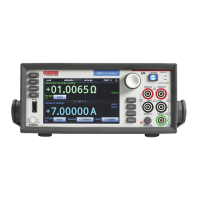2400S-903-01 Rev. E / September 2011 Return to Section Topics 1-37
Series 2400 SourceMeter® Quick Start Guide Section 1: Introduction
Figure 1-10
Pulse-measure timing
Pulse width — The setting range for pulse width is from 150µsec to 5msec. Note however, that
the minimum pulse width that can be achieved in Figure 10 is determined by the minimum pulse
width overhead (80µsec), and the time it takes to measure the signal. For example if the measure
speed is set to 0.1 PLC, it will take 1.667msec to measure the signal (0.1/60Hz). Therefore, the
minimum pulse width would be 1.747msec. Setting pulse width to a value less than that is ignored.
If (for the same example) the pulse width setting e
xceeds 1.747msec, the difference becomes the
“Delay” portion of the output on-time. If you set pulse width to 3msec, then the “Delay” becomes
1.253msec.
For remote operation, all measurements can be disabled. This reduces on-time overhead to
150u
sec (minimum).
Output off-time — As shown in Figure 10, the output off-time consists of a minimum overhead
(2.9msec), the time it takes to measure the reference and zero, and the user-set pulse delay (PD).
For example, if the measure speed is set to 0.1 PLC, it will take 3.334msec to measure the
reference and zero (2 x 1.667msec). With pulse delay set to zero, the minimum pulse off-time
would be 6.234msec.
The output off-time can be reduced by
disabling auto-zero. With auto zero disabled, the reference
and zero are not measured, and the overhead time is reduced to 1.4msec (minimum). With auto
zero disabled, zero drift will eventually corrupt accuracy.
For remote operation, all measurements can be disabled. This reduces off-time overhead to
1.1msec (minimum).
Pulse duty cycle
Duty cycle, the percentage of time during the pulse period that the output is on, is calculated as
follows:
Duty cycle = Pulse width / (Pulse width + Off-time)
For example, if the pulse width is 1msec and the off-
time is 9msec, duty cycle is calculated as
follows:
Duty Cycle = 1msec / (1msec + 9msec)
= 1msec / 10msec
= 0.10 (10%)
